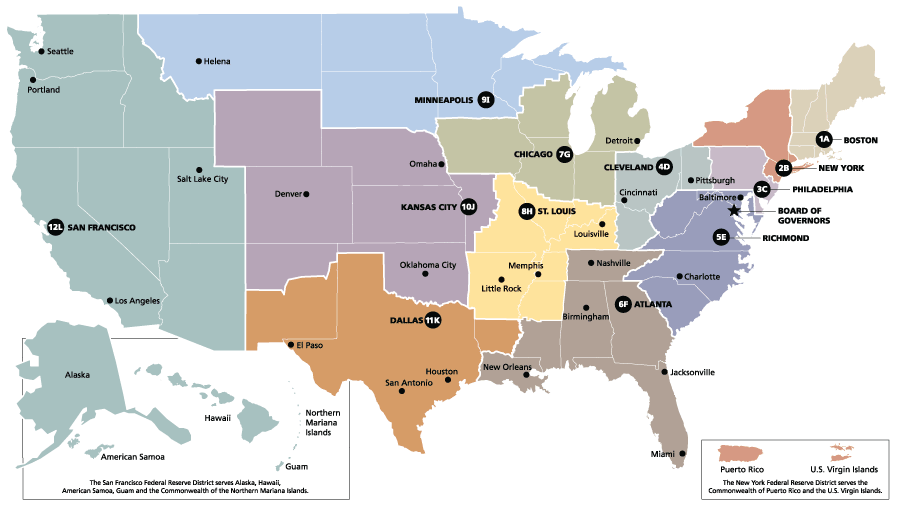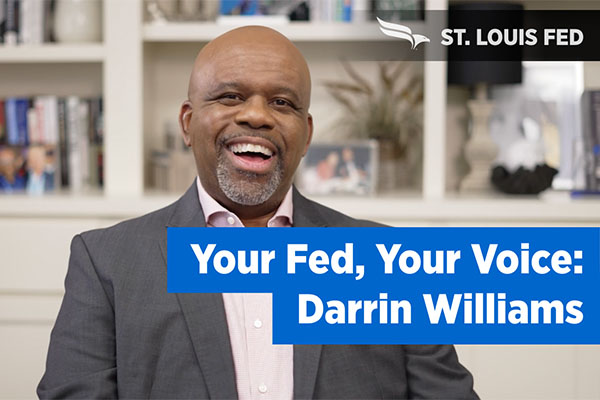Explained: A Federal Reserve Bank’s Board of Directors
The Federal Reserve—“the Fed” for short—is the central bank of the United States. But the Federal Reserve System approved by Congress in the 1913 Federal Reserve Act is decentralized by design so that U.S. monetary policy reflects economic realities from all over the nation.
A prime illustration of this decentralized structure are the 12 Federal Reserve districts and the regional Reserve banks that serve them.
The Fed’s 12 Reserve Banks

The 12 districts are headquartered in Boston – 1, New York – 2, Philadelphia – 3, Cleveland – 4, Richmond – 5, Atlanta – 6, Chicago – 7, St. Louis – 8 (that’s us!), Minneapolis – 9, Kansas City – 10, Dallas – 11, and San Francisco – 12.
As specified in the Federal Reserve Act, these banks operate within their own geographic areas and are separately incorporated.
Moreover, each of the 12 Federal Reserve banks is overseen by a nine-member independent board of directors. Much like the Reserve districts themselves, the nine-member boards were built to be broadly representative.
This article overviews Reserve bank boards of directors: who they are and what they do.
The Board of Governors vs. a Reserve Bank’s Board of Directors
Before getting into details, it’s essential to distinguish between the Federal Reserve Board of Governors and a Federal Reserve bank’s board of directors. If you Google (or Bing) either term, you’ll likely see results for both. They are not the same.
Federal Reserve Board of Governors
The Board of Governors is a U.S. government agency located in Washington, D.C. When fully staffed, it has seven governors. The governors are appointed by the president and confirmed by the Senate.
What does the Board of Governors do? It’s the central governing body of the whole Federal Reserve System. The Board oversees the operations of the 12 Reserve banks, and it shares with them the responsibility for supervising/regulating certain financial institutions. The Board also helps ensure that consumers’ and communities’ voices are heard by the central bank.
Importantly, the seven governors all have a vote on the Federal Open Market Committee, or FOMC, which is the body that decides the direction of U.S. monetary policy. (If you hear in the news that the Fed made a decision on the target for the federal funds rate, that’s the FOMC.)
Here’s a helpful primer on the FOMC and Board of Governors.
Reserve Bank Board of Directors
As we previewed in the intro, the head offices of the 12 Reserve banks each have a nine-member board. The Federal Reserve Act framers built a decentralized structure to represent the voice of Main Street and to avoid having only a single, central entity based in Washington, D.C., or on Wall Street.
That’s why the Federal Reserve System features a blend of public and private characteristics. A Reserve bank’s board of directors brings a variety of private sector experience, and directors serve as one of many touchpoints between the Federal Reserve and the general public.
What Does the Board of Directors Do?
Directors play a vital role in keeping the Fed functioning effectively. Here are a few of the ways they do this.
Helping the Fed Take the Pulse of a District’s Economy
Directors help shed light on economic and credit conditions in their districts. They are chosen to represent a variety of occupational sectors, demographic groups and geographic areas—which helps the Fed glean information from every corner of the nation.
“I think it’s important that we are in a position to influence how the Federal Reserve feels about local economies and especially about rural America, and I think it’s invaluable to the Fed as they try to develop monetary policy,” says then-St. Louis Fed board member Elizabeth McCoy in a Voices of the Fed video. She is CEO of Planters Bank, with branches spanning western Kentucky and part of Tennessee.
Acting as a Link between the Federal Reserve and the Public
Directors also help Reserve banks in representing the voice of Main Street. Along with providing insights on economic conditions in their regions and sectors to the Fed, directors play a role in helping communicate information about Federal Reserve actions and policies to the public.
Performing Corporate Governance
The administrative functions and corporate governance responsibilities of a Reserve Bank’s head-office board of directors are akin to those of any firm. These include:
- Reviewing the Reserve bank’s annual goals and objectives
- Reviewing the performance of the Reserve bank’s president and first vice president
- Providing guidance for major capital projects
- Maintaining an effective system of internal auditing procedures and controls
Importantly, Reserve bank directors have no involvement in matters related to banking supervision, including specific supervisory decisions. Those are functions of the Board of Governors. For more about the important roles and responsibilities of directors, see this Federal Reserve guide (PDF).
Who Serves on a Reserve Bank’s Board of Directors?
On a Reserve bank’s nine-member board, there are three classes of directors: Class C, B and A.
Three Class C Directors Who Represent the Public
In each Federal Reserve district, three Class C directors are chosen to represent the public. By statute, the Board of Governors appoints Class C directors. The Board of Governors also designates a Reserve bank’s board chair and deputy chair from the Class C directors.
Due-but-not-exclusive consideration is given so that these directors represent the interests of:
- Agriculture
- Commerce
- Industry
- Services
- Labor
- Consumers
By statute, Class C directors cannot be officers, directors or employees of a bank, nor can they own stock in a bank. (In terms of affiliations, the Board of Governors has extended this prohibition to other types of financial institutions that the Fed supervises. This is discussed in more detail in the Board of Governors’ eligibility documentation regarding directors (PDF) and in a Fed publication on roles and responsibilities of directors (PDF).)
Three Class B Directors Who Represent the Public
Class B directors likewise represent the public, with due-but-not-exclusive consideration given to the interests of agriculture, commerce, industry, services, labor and consumers. By statute, this class is nominated and elected by the member banks in each Federal Reserve district.
What’s a “member bank”? These are commercial banks that are members of the Federal Reserve System and are stockholders in their district’s Reserve bank. National banks must be members of the Federal Reserve System; any financially sound, well-managed state-chartered bank may become a member of the System. Some background: Holding a certain amount of stock is, by law, a condition of a commercial bank’s Federal Reserve System membership. It does not carry with it the control and financial interest given to holders of common stock in a for-profit organization. Reserve banks like the St. Louis Fed are not operated for profit; they are required to transfer net earnings to the U.S. Treasury.
By statute, Class B directors may not be officers, directors or employees of a bank. The Board of Governors has extended this prohibition to other types of financial institutions supervised by the Fed, although Class B directors can be affiliated with a savings and loan holding company below a certain size.
Three Class A Directors Who Represent District Member Banks
Class A directors are elected by member banks in the District to represent the banking industry.
Pursuant to the Dodd-Frank Act, which revised the Federal Reserve Act, Class A directors have been prohibited from participating in the appointment of Reserve bank presidents and first vice presidents. In the spirit of the law, the Board of Governors has extended that to say Class A directors may not participate in other aspects (PDF) of the appointment process, like serving on a search committee.
At-a-Glance: How Reserve Bank Boards of Directors Are Chosen

The process for choosing directors for the boards of regional Reserve banks, like the St. Louis Fed, helps to ensure broad representation in the discussions that inform monetary policymaking decisions.
SOURCE: Image courtesy of Roles and Responsibilities of Federal Reserve Directors (PDF), a Federal Reserve System publication.
Branching Out

How is your community reflected in the Fed’s work? Southern Bancorp CEO Darrin Williams talks about his work on the St. Louis Fed’s Little Rock Branch board of directors advocating for financial inclusion in underserved communities.
With branches in Little Rock, Ark., Louisville, Ky., and Memphis, Tenn., the St. Louis Fed (like other Fed banks with branches) also has boards of directors serving these branch offices. Some branch directors are appointed by the Reserve bank, and the others are appointed by the Board of Governors. Like the head-office board, they contribute to the System’s overall understanding of the economy.
A System to Serve the Public Interest
The Federal Reserve System founded by Congress over 100 years ago can seem complex. It’s a decentralized central bank with a blend of public- and private-sector elements.
But understanding the role of a Reserve bank’s board of directors is one way to learn how the Fed listens to Main Street.
In the Eighth Federal Reserve District, for example, members of the St. Louis Fed’s board of directors and its branch boards contribute vital information about economic and credit conditions, as they do in other Fed districts.
Directors are among those who represent the many voices of Main Street that help inform the work of the Federal Reserve.
Editor's Note: This blog post, originally published Jan. 13, 2021, has been updated with a new video promotion.
Notes
- This is discussed in more detail in the Board of Governors’ eligibility documentation regarding directors (PDF) and in a Fed publication on roles and responsibilities of directors (PDF).
- Some background: Holding a certain amount of stock is, by law, a condition of a commercial bank’s Federal Reserve System membership. It does not carry with it the control and financial interest given to holders of common stock in a for-profit organization. Reserve banks like the St. Louis Fed are not operated for profit; they are required to transfer net earnings to the U.S. Treasury.
This blog explains everyday economics and the Fed, while also spotlighting St. Louis Fed people and programs. Views expressed are not necessarily those of the St. Louis Fed or Federal Reserve System.
Email Us


